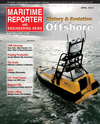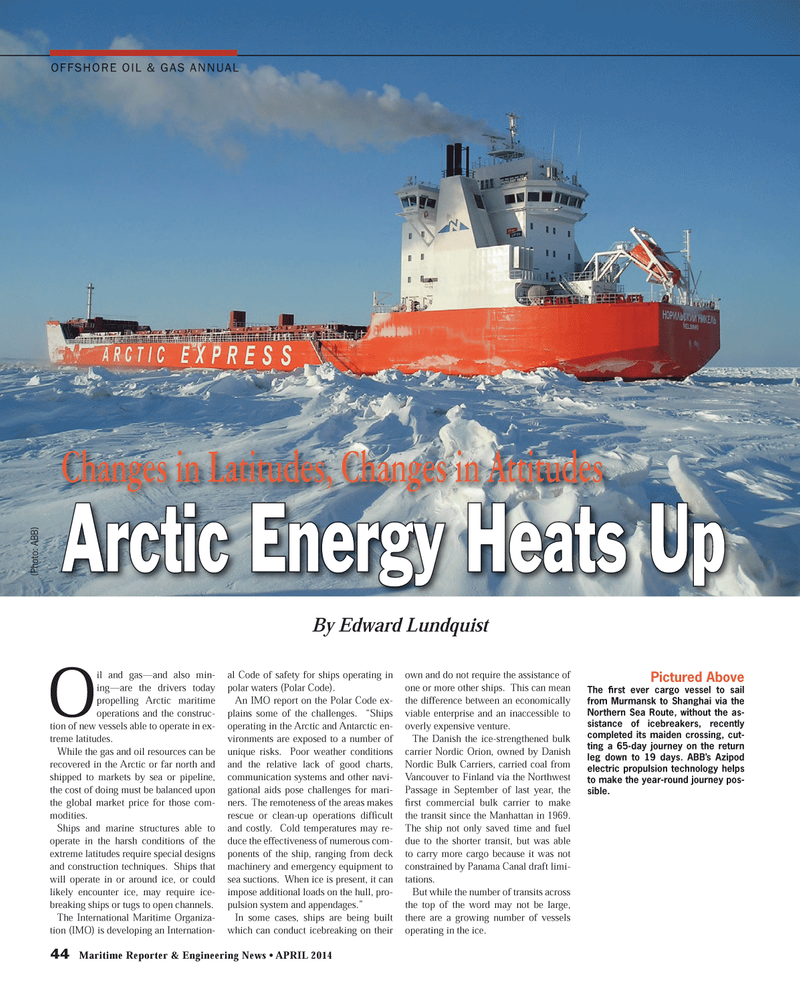
Page 44: of Maritime Reporter Magazine (April 2014)
Offshore Edition
Read this page in Pdf, Flash or Html5 edition of April 2014 Maritime Reporter Magazine
44 Maritime Reporter & Engineering News ? APRIL 2014 OFFSHORE OIL & GAS ANNUAL Oil and gas?and also min-ing?are the drivers today propelling Arctic maritime operations and the construc-tion of new vessels able to operate in ex-treme latitudes. While the gas and oil resources can be recovered in the Arctic or far north and shipped to markets by sea or pipeline, the cost of doing must be balanced upon the global market price for those com-modities. Ships and marine structures able to operate in the harsh conditions of the extreme latitudes require special designs and construction techniques. Ships that will operate in or around ice, or could likely encounter ice, may require ice-breaking ships or tugs to open channels. The International Maritime Organiza- tion (IMO) is developing an Internation-al Code of safety for ships operating in polar waters (Polar Code).An IMO report on the Polar Code ex-plains some of the challenges. ?Ships operating in the Arctic and Antarctic en- vironments are exposed to a number of unique risks. Poor weather conditions and the relative lack of good charts, communication systems and other navi-gational aids pose challenges for mari-ners. The remoteness of the areas makes rescue or clean-up operations difÞ cult and costly. Cold temperatures may re- duce the effectiveness of numerous com- ponents of the ship, ranging from deck machinery and emergency equipment to sea suctions. When ice is present, it can impose additional loads on the hull, pro-pulsion system and appendages.?In some cases, ships are being built which can conduct icebreaking on their own and do not require the assistance of one or more other ships. This can mean the difference between an economically viable enterprise and an inaccessible to overly expensive venture.The Danish the ice-strengthened bulk carrier Nordic Orion, owned by Danish Nordic Bulk Carriers, carried coal from Vancouver to Finland via the Northwest Passage in September of last year, the Þ rst commercial bulk carrier to make the transit since the Manhattan in 1969. The ship not only saved time and fuel due to the shorter transit, but was able to carry more cargo because it was not constrained by Panama Canal draft limi-tations.But while the number of transits across the top of the word may not be large, there are a growing number of vessels operating in the ice.Changes in Latitudes, Changes in Attitudes Arctic Energ Arctic Energ y Heats Upy Heats UpBy Edward Lundquist(Photo: ABB)Pictured Above The Þ rst ever cargo vessel to sail from Murmansk to Shanghai via the Northern Sea Route, without the as- sistance of icebreakers, recently completed its maiden crossing, cut- ting a 65-day journey on the return leg down to 19 days. ABBÕs Azipod electric propulsion technology helps to make the year-round journey pos- sible. MR #4 (42-49).indd 44MR #4 (42-49).indd 444/7/2014 4:01:54 PM4/7/2014 4:01:54 PM

 43
43

 45
45
